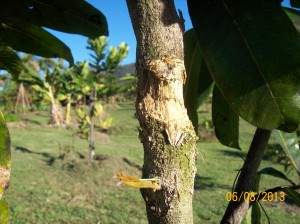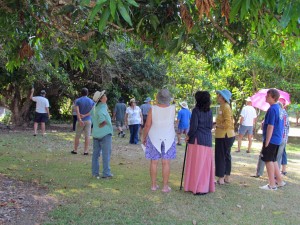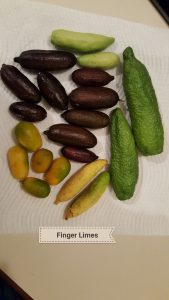Gene Pool Branches Out
28/11/2005 // 0 CommentsWhatever happened to the collection of valuable fruit trees, after the Queensland Department of Primary Industries’ Kamerunga research station, on the bank of the Barron River just west of Cairns, closed about a decade ago?
Published in Australian Rare Fruit Review, January 2006
Kamerunga was home to an important genetic pool of trees. At the time, there was speculation from growers and other interested people that significant research material – cultivar benchmarks – would be lost forever, to the detriment of scientists, botanists, as well as farmers, backyard growers and their many customers.
It was also the time when Brian Watson, Manager for QDPI Horticulture Branch in North Queensland, and Jim Wait, Horticulture Adviser at Kamerunga, were retiring. As well, the organisation was restructuring. What was going on? Was this the end of an era?
In the July, 1991 Rare Fruit Council Newsletter, Brian Watson sought to quell some of the concerns. Brian speculated that staff would be centralised at either South Johnstone Research Station or another site in the Innisfail area, to reduce departmental costs and provide a “centre of excellence” with adequate numbers of research, extension and regulation staff working together.
“Good facilities and an adequate number of staff in one centre will generate better staff interaction and stimulation, increased numbers of visiting scientists, and better programs,” he wrote.
“Concern has also been expressed by some parties as to the loss of valuable fruit tree gene pools from Kamerunga. In real terms there will be negligible loss because of past policies in promoting transfer of gene pool material to co-operators and the nursery industry.
“The gene pools for cultivars of lychee, longan, mango, durian, rambutan, pummelo, coffee, etc, have already been moved to South Johnstone, Tableland and Ayr Research Stations, and in fact have been expanded. There will also be transfer of a few species and cultivars not commonly present in North Queensland outside Kamerunga.
“In terms of research programs, Kamerunga has never been regarded as a botanical garden – and when trees cease to provide relevant research information then their value is limited. Thus, comments from growers and other interested parties to our public service and government on the demise of Kamerunga should be realistic.
“The points to emphasise in supporting an adequate level of QDPI research and extension in North Queensland are – the future objectives. That is, what projects and programs are required and what resources should be provided? It is probably not appropriate just to make maudlin comments about services provided in the past, and the loss of trees which in fact may have now largely passed the point of scientific usefulness.”
The old Kamerunga site – which still has some of the original fruit trees growing – has been earmarked by Cairns Water for a massive water filtration plant. Whether the former research trees survive much longer is questionable. While work on it is yet to start on the treatment plant, to supply the city’s thousands of new homes and businesses, just across the road a large housing estate is rapidly taking shape. This leafy, quiet corner of Cairns is changing forever.
At DPI South Johnstone, Research Station Manager Pedro O’Connor, said a number of varieties from Kamerunga were doing well. But, he said, there had been a selection process underway for some years and only promising varieties were being retained.
“Rambutans were taken to South Johnstone, but only six or eight varieties were considered worth pursuing on a commercial basis,” he said. “We have worked closely with farmers to trial the best, and these are the varieties now growing in on farm and supplying markets nationally and internationally. So, the trials have been demonstrably successful at the farm level, growers know what they want in terms of bearing, colour, taste, size and so on. Our rambutans were phased out in April this year, having reached the end of their scientific usefulness.”
Mangoes have gone from Kamerunga to South Johnstone and then on to Ayr and South Edge near Mareeba – the latter Research Station is also experimenting with lemongrass, sugar cane and native foliage. Disease took its toll with durians. But some trees such as breadfruit and marang appear to have “gone missing”, although enthusiasts would almost certainly have collected stock.
Mangosteen seedlings are always true to the parent tree. However, Pedro said recent DNA testing had shown some slight differences in tree form and fruit characteristics, some fruit types are more egg-shaped rather than round. “I have grown mangosteens for about 15 years, and of our 1,200 trees only two trees exhibited different DNA profiles.
“We still have some of the original Kamerunga stock of coffee and tea. Our pomelo collection is about 17 years old and probably will be removed in another 12 months as the best selections are now grown extensively on commercial farms.
“So, in a nutshell, any good plant stock from Kamerunga is alive and well – and it’s out there on the farms. The productive, sought-after part of the gene pool is still with us, and thriving.”
Pedro said the South Johnstone Research Station’s new arboretum was attracting plenty of attention. “It has a collection of mixed species, some of which have come from Alan Carle, at the Botanical Ark in the Whyanbeel Valley near Mossman, and also from Michael Fabian, recently retired from Limberlost Nursery in Cairns,” he said.
Similar posts
-

RFCA Archives for 'The Exotics' magazine
12/05/2016 // 0 CommentsThese archives are the work of Pat Scott from Western Australia who created this website for all of ...
-

Gin Gin School fruit orchard update 2015
19/04/2016 // 0 Comments -

FRUIT EATING DOG
11/04/2014 // 0 CommentsHello again from God's own country in Central Queensland. At the end of last year I inherited a dog....
-

Never ever believe all that you read
24/01/2014 // 0 CommentsLOOK! What happened to the trunk of fruit tree after Vaseline was used and then removed next ...







